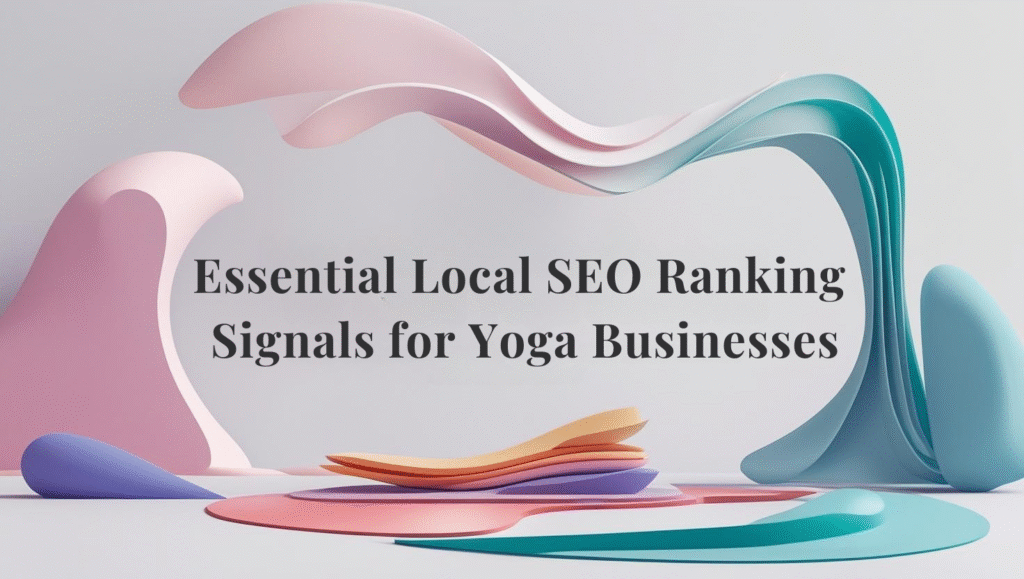Ranking #1 for ‘Yoga Near Me’: A Step-by-Step SEO Blueprint
Summary: Ranking for “yoga near me” requires more than just adding location keywords; it involves a complete local SEO strategy tailored to how people search for yoga services in their area. From optimizing your Google Business Profile and website content to building local backlinks and encouraging customer reviews, every step contributes to better visibility and higher rankings.
Key Takeaways:
- Local SEO is essential for yoga studios to attract nearby clients.
- “Yoga near me” keywords drive high-intent local traffic.
- Google Business Profile boosts visibility in map searches.
- Regular content updates maintain SEO performance.
- Tracking SEO metrics helps refine and grow results.
Are your yoga classes running half-empty while your competitors stay fully booked? Wondering why your studio isn’t showing up when people search for “yoga near me”? The problem isn’t your service it’s your visibility. With this digitalization, most people turn to Google to find local services, and if your studio doesn’t appear in those top results, you’re simply invisible to potential clients. That’s where local SEO and “near me” keywords make all the difference. These searches come from users who are ready to take action. Ranking for them means more clicks, more calls, and more bookings. In this blog, you’ll discover a proven SEO blueprint to help your yoga studio rise to the top of local searches and stay ahead of the competition.
Table of Contents
Toggle- How SEO Helps Yoga Studios Rank for ‘Yoga Near Me’?
- Key SEO Ranking Factors for Local Yoga Searches
- Step-by-Step SEO Blueprint to Rank #1 in 2025
- Step 1: Keyword Research for Local Yoga Queries
- Step 2: Analyze Google’s First Page for 'Yoga Near Me'
- Step 3: Identify Your Local Competitors
- Step 4: On-Page Optimizations with Local Focus
- Step 5: Optimize for Local Search Intent
- Step 6: Publish High-Quality Localized Content
- Step 7: Strengthen Local SEO Signals
- Step 8: Make Your Website Mobile-Friendly
- Step 9: Build Local Backlinks & Citations
- Step 10: Boost Local Visibility Using Social Media
- Step 11: Optimize for Voice Search
- Step 12: Improve Website Loading Speed
- Step 13: Re-optimize Existing Pages Regularly
- Step 14: Track SEO Progress and Refine
- How Agha DigiTech Can Help Your Yoga Studio Rank Locally?
- Final Thoughts
- Frequently Asked Questions (FAQ's)
How SEO Helps Yoga Studios Rank for ‘Yoga Near Me’?
For yoga studios, SEO plays a critical role in showing up when potential clients search for terms like “yoga near me,” “beginner yoga in [city],” or “hot yoga studio nearby.” It ensures your studio appears in Google’s local map listings and top organic results right where users are looking when they’re ready to join a class. With the right local SEO strategy, your studio becomes more discoverable to people actively seeking yoga sessions in your area.
By optimizing your website and Google Business Profile with location-based keywords, clear class details, schedules, and authentic reviews, you increase your chances of being chosen over competitors. Whether you’re offering power yoga, prenatal yoga, or meditation sessions, SEO services help attract the right audience in your neighborhood. It’s not just about being online it’s about being visible to the right people at the right time.
Key SEO Ranking Factors for Local Yoga Searches

For a yoga studio to rank higher in local search results like “yoga near me,” it’s essential to understand what search engines prioritize. From your website content to how your studio appears across the web, several elements influence your visibility. Below are the key SEO ranking factors that directly impact how well your yoga studio performs in local search.
On-Page SEO for Yoga Studio Websites
On-page SEO involves optimizing your website’s content, structure, and metadata to align with relevant local search terms. For yoga studios, this includes using city-specific keywords, optimizing class pages, embedding maps, and showcasing testimonials. Well-structured content helps search engines understand your offerings while guiding users to take action easily.
Benefits for yoga studios:
- Targets keywords like “yoga in [city]”
- Improves class page visibility
- Enhances user experience with structured content
Off-Page SEO to Build Local Authority
Off-page SEO focuses on external elements like backlinks, directory listings, and customer reviews. These signals show Google that your studio is trusted and locally relevant. Getting featured in local blogs, collaborating with nearby wellness centers, and encouraging reviews all contribute to building a strong online reputation.
Benefits for yoga studios:
- Builds credibility with Google and users
- Increases referral traffic from local sites
- Boosts Google Map rankings through reviews
Technical SEO for Better Performance
Technical SEO ensures that your website runs smoothly, loads quickly, and is accessible across all devices. A mobile-optimized and error-free site is essential, especially since most “near me” searches happen on smartphones. It also includes submitting sitemaps, improving site architecture, and ensuring all pages are crawlable by search engines.
Benefits for yoga studios:
- Faster load times reduce bounce rates
- Mobile optimization helps capture “near me” users
- Proper indexing improves visibility across search engines
Step-by-Step SEO Blueprint to Rank #1 in 2025
Climbing to the top of local search results for “yoga near me” requires more than just keywords; it needs a well-structured, consistent SEO approach. Below is a step-by-step blueprint designed specifically for yoga studios to improve local visibility, attract targeted traffic, and convert more leads into regular members in 2025. As wellness continues to merge with the broader healthcare industry, having a strong digital presence ensures your studio is discoverable by health-conscious individuals seeking holistic fitness solutions.
Step 1: Keyword Research for Local Yoga Queries
For yoga studios, keyword research should focus on finding location-specific and intent-driven terms that potential clients use when looking for classes nearby. Phrases like “yoga near me,” “beginner yoga in [city],” or “hot yoga [neighborhood]” are highly effective. Use tools like Google Keyword Planner, Ubersuggest, or SEMrush to uncover local keyword opportunities. Don’t ignore long-tail keywords they may have lower search volume but usually convert better. Also, pay attention to seasonal and service-specific trends, such as “morning yoga classes” or “prenatal yoga near me.” These terms help connect your studio with users who are actively looking to join a class or schedule a session.
Step 2: Analyze Google’s First Page for 'Yoga Near Me'
Search your target terms (like “yoga near me” or “yoga in [your city]”) and study the top-ranking pages. Observe what Google shows in the local pack, organic listings, featured snippets, and FAQs. Look at the type of content are they directories, studio websites, blog posts, or booking platforms? Analyze their use of keywords, business details, images, and reviews. This insight helps you understand what works and what your website must include or improve upon. Take note of what competitors are doing right, then identify content or experience gaps you can fill to outperform them in both local search and user satisfaction.
Step 3: Identify Your Local Competitors
Find out which yoga studios in your area consistently appear in Google’s top local results and map listings. Use SEO tools like Ahrefs, SEMrush, or BrightLocal to analyze their backlink profiles, content strategies, and keyword rankings. Look at their class offerings, Google reviews, blog activity, and site structure. Identify what makes them successful such as strong local citations, social media presence, or partnerships and spot opportunities they’ve missed. By understanding your competitors’ digital footprint, you can tailor your SEO strategy to highlight your unique offerings, create stronger content, and gain an edge in your local market.
Step 4: On-Page Optimizations with Local Focus
Optimize each page on your website with relevant, location-based keywords. Use titles like “Yoga Classes in [City]” or “Beginner Yoga Studio Near [Neighborhood].” Make sure to add your city name naturally in headings, URLs, and content without keyword stuffing. Highlight your class types, schedules, instructor bios, and client testimonials. Embed a Google Map with your exact location and include schema markup for local businesses. This helps search engines understand your geographic relevance. On-page SEO ensures your site is not only informative for visitors but also properly indexed by Google for local intent, boosting visibility and conversions.
Step 5: Optimize for Local Search Intent
Understanding and addressing local search intent is essential for attracting users who are ready to take action. When someone searches “yoga near me,” they’re usually looking for a studio to visit immediately or schedule a class soon. Make sure your website delivers the information they’re looking for class timings, pricing, nearby parking, contact details, and easy booking options. Add quick-access buttons like “Join Now” or “View Schedule” on your homepage. Use clear, persuasive CTAs and keep your content relevant to real-time user needs. Matching your site content with user intent increases your chances of converting local traffic into paying clients.
Step 6: Publish High-Quality Localized Content
Creating localized content not only builds authority but also helps you rank for a wider range of long-tail keywords. Write blog posts about topics like “Best Yoga Classes in [City],” “What to Expect at Your First [City] Yoga Class,” or “Yoga Events Happening in [Month/City].” Share updates about new programs, seasonal offers, and wellness tips that matter to your local community. Include keywords naturally, and add internal links to your core class or contact pages. This kind of content shows Google and your audience that your studio is active, trustworthy, and deeply connected to the local fitness scene.
Step 7: Strengthen Local SEO Signals
Claim and optimize your Google Business Profile (GBP) with accurate business details, including name, address, phone number, website link, class categories, and operating hours. Upload high-quality photos of your studio, instructors, and class sessions to make your listing more engaging. Encourage satisfied clients to leave detailed, positive reviews and respond to them professionally. Also, ensure your studio is listed on reputable directories like JustDial, Practo, Fitternity, and Yelp. Consistent NAP (Name, Address, Phone) data across all platforms strengthens trust signals for Google and improves your chances of ranking higher in the map pack and local searches.
Step 8: Make Your Website Mobile-Friendly
Most people searching for “yoga near me” are doing so on their smartphones. Your website needs to load quickly, display properly across devices, and offer an intuitive user experience. Use responsive design, compress images, and ensure that clickable elements are mobile-friendly. Make it easy to book a class, contact the studio, or view your location on a map. A slow or clunky mobile experience can cost you potential clients. Google also favours mobile-optimised sites in local rankings, so improving your mobile usability not only boosts engagement but also supports your visibility in local search results.
Step 9: Build Local Backlinks & Citations
Building backlinks from reputable, locally relevant sources strengthens your studio’s online authority. Reach out to fitness bloggers, wellness influencers, local newspapers, and community sites to feature your classes or guest posts. Get your studio listed on high-authority platforms like Yelp, JustDial, Sulekha, Practo, and Fitternity. These citations validate your presence and increase your chances of being shown in local packs. Also, consider sponsoring local wellness events or offering free classes to community groups in exchange for online mentions. Each quality link and citation tells search engines that your studio is trustworthy, well-established, and deserving of higher rankings.
Step 10: Boost Local Visibility Using Social Media
While social media doesn’t directly affect rankings, it plays a vital role in boosting local SEO for yoga studios. Platforms like Instagram and Facebook help generate local engagement that reinforces your studio’s geographic relevance. Use geo-tags, local hashtags, and location mentions in your posts to signal to search engines that your studio serves a specific area. Encourage check-ins and reviews through your social channels to drive more interactions on your Google Business Profile. Sharing localized content such as community yoga events or collaborations with nearby wellness brands further increases brand awareness and improves visibility in local search results over time.
Step 11: Optimize for Voice Search
With more people using smart speakers and mobile voice assistants, optimizing for voice search is becoming essential. Voice queries are often longer and more conversational for example, “Where can I find beginner yoga classes near me?” Structure your content to include natural language and FAQs that reflect how people speak. Add clear answers to common local questions, such as pricing, location, availability, and class types. Voice optimization increases your chances of being the top result read aloud by devices, giving your studio an edge over competitors who haven’t adapted to this growing search trend.
Step 12: Improve Website Loading Speed
Page speed directly affects both user experience and search engine rankings. A slow website frustrates visitors and increases bounce rates, especially on mobile. Optimize loading times by compressing images, reducing unnecessary plugins, enabling caching, and choosing a reliable hosting provider. Use tools like Google PageSpeed Insights or GTmetrix to identify issues and implement fixes. A fast-loading site not only improves user engagement but also boosts your SEO, helping your yoga studio rank better for “near me” queries and keep potential clients interested long enough to explore your offerings and book a class.
Step 13: Re-optimize Existing Pages Regularly
SEO isn’t a one-time task it’s an ongoing process. Periodically review your existing website content to ensure it’s still relevant, up-to-date, and competitive. Refresh older blog posts with new data or keywords, update service pages with current class schedules and offers, and add internal links to new pages. Monitor how each page performs and adjust based on analytics insights. Re-optimizing content ensures your site remains fresh in the eyes of both search engines and users. It also helps maintain your visibility in local search results, preventing your competitors from overtaking your position with newer, more relevant content.
Step 14: Track SEO Progress and Refine
To measure the success of your SEO efforts, track metrics like local keyword rankings, organic traffic, bounce rates, and conversions. Use tools such as Google Analytics, Search Console, BrightLocal, or Ahrefs to monitor performance. Set up tracking for key goals like class bookings, contact form submissions, or calls. Evaluate what’s working such as which blog posts bring in the most local traffic and replicate those strategies. Identify gaps where your site may be underperforming and make data-driven adjustments. Regular monitoring and refinement keep your yoga studio competitive and aligned with constantly changing search engine algorithms.
How Agha DigiTech Can Help Your Yoga Studio Rank Locally?
Yoga studios often struggle with visibility in saturated local markets, especially when competing with established names and aggregator platforms. Agha DigiTech helps bridge that gap with SEO strategies specifically designed to improve local search performance. From optimizing your Google Business Profile to ensuring consistent local listings and on-page enhancements, every effort is aimed at increasing your chances of appearing in “near me” results.
With a deep understanding of the yoga and wellness industry, our team crafts content that highlights your unique offerings, location, and client experience. We focus on building your online authority through backlinks, reviews, and mobile-friendly site structures that appeal to both users and search engines. Whether you’re a boutique studio or a growing franchise, Agha DigiTech ensures your digital presence converts searchers into regular clients.
Final Thoughts
Ranking #1 for “yoga near me” isn’t just about adding keywords it requires a complete local SEO strategy that aligns with how your potential clients search and engage online. From keyword research to mobile optimization and review generation, every step plays a role in boosting your studio’s visibility and footfall.
If you’re ready to increase your local reach, attract more students, and grow your yoga studio sustainably, Agha DigiTech is here to help. Our proven SEO solutions are designed to put your business on the local map literally and digitally. Get in touch with us today and let’s elevate your studio to the top of local search results.
Frequently Asked Questions (FAQ's)
What is the ‘Local 3-Pack,’ and why does it matter?
The Local 3-Pack is the boxed map listing that appears above organic results in local searches. Being featured here gives your yoga studio maximum visibility, especially on mobile. Optimizing your GBP, getting positive reviews, and maintaining NAP consistency across directories can help you earn a spot in this top-tier section.
Why is page speed essential for profile performance?
Page speed has a direct impact on both user experience and local SEO rankings. Slow-loading sites result in higher bounce rates, particularly on mobile devices. A fast, responsive website keeps users engaged, increases the likelihood of bookings, and improves your chances of ranking well in local searches like “yoga near me.”
What local keywords should I target?
Focus on keywords that combine your service with a location, like “yoga classes in [City]” or “hot yoga near me.” These long-tail, location-specific keywords attract users who are actively looking for a class nearby. Including variations for services, times, and specialties can help capture a broader, more targeted local audience.
How important are customer reviews?
Customer reviews are one of the strongest local SEO signals. Consistent, positive reviews help build credibility and trust with both users and search engines. Encourage your students to leave detailed feedback on platforms like Google, Facebook, or JustDial. Responding to reviews also boosts engagement and signals reliability to Google’s algorithm.
Should I create separate pages for multiple studio locations?
Absolutely. Creating separate landing pages for each studio location allows you to target specific local keywords and provide relevant details like address, schedule, and unique offerings. This enhances user experience, improves SEO rankings for each area, and increases your visibility when people search for yoga classes in specific neighborhoods.




